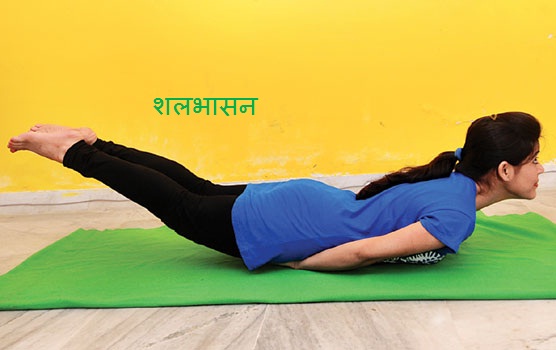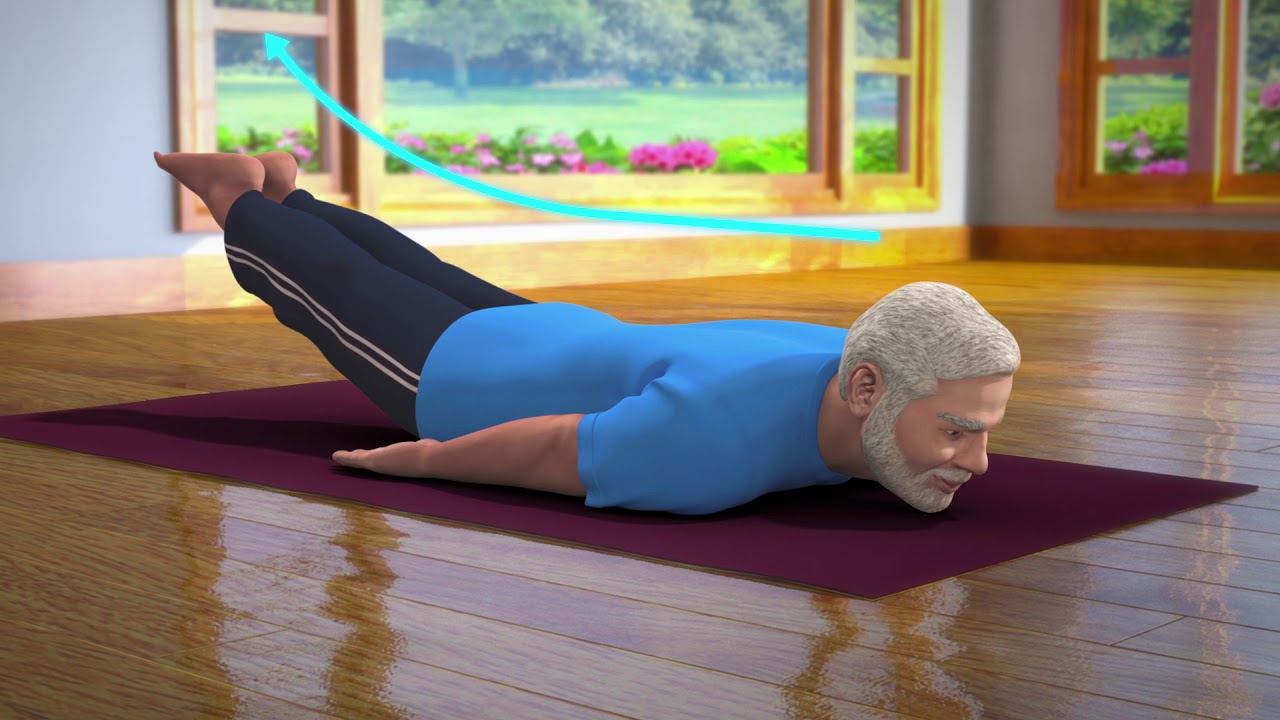Salabhasana

Salabhasana belongs to a group of asanas called the “baby backbends.” Its Sanskrit name, salabha means “grasshopper” or “locust.” Also called the Locust Pose, Salabhasana is a seemingly simple pose that is more challenging and interesting than it appears on the surface.
Step by Step
-
Lie on the belly with arms along your torso’s sides. The forehead should rest on the ground and palms face upwards
-
Turn big toes to face each other and firm your buttocks in order for the coccyx to press toward the pubis
-
Exhale and lift up your head, legs, arms, and upper torso away from the ground, allowing you to rest on the lower ribs, front pelvis, and belly
-
Firm the buttocks and strongly reach through the legs, starting from the heels and proceeding to the big toes.
-
Keep your big toes facing toward each other
-
Raise arms parallel to the ground and stretch back through the fingertips
-
Imagining that there is a weight pressing down on your upper arms’ backs, push up in the ceiling’s direction against this resistance.
-
Draw your shoulder blades towards each other, opening the chest.
-
Gaze slightly upward or forward, being careful enough to avoid jutting the chin forward and crunching the back of the neck.
-
Keep your skull’s base lifted and the neck’s back long
-
Stay here for about 30 seconds or 1 minute before releasing with an exhalation
-
Take a couple of breaths before repeating the process
Modifications
If you find it hard to hold this pose;
-
Support the lower sternum area with a rolled-up blanket to keep the lift of the upper torso, or
-
Support your thigh’s front with a rolled-up blanket to keep your leg’s lift
Preparatory Poses
The performance of Salabhasana in several yoga styles such as Ashtanga and Bikram comes after Bhujangasana. This preparatory asana is closely related to the pose but works on a separate area of the spine. Other poses include:
-
Gomukhasana
-
Setu Bandha Sarvangasana
-
Supta Virasana
-
Urdhva Mukha Svanasana
-
Virabhadrasana I
-
Virasana
Follow Up Poses
This pose offers great preparation for all “baby backbends” such as Ustrasana and Dhanurasana. Other follow-ups can be:
-
Bharadvajasana
-
Setu Bandha Sarvangasana
-
Salamba Sarvangasana
Benefits
-
Strengthens muscles of the buttocks, spine, and arms’ and legs’ backs
-
Stretches the chest, shoulders, belly, and thighs
-
Improves posture
-
Helps relieve stress
-
Stimulates abdominal organs
Bandhas
-
Mula Bandha
Drishti
-
Forward, toward the nose (Nasagre)
Variations
This asana has the following variations:
-
Ardha Salabhasana (Half Locust Pose)
-
Poorna Salabhasana (Full Locust Pose)
-
Makarasana (“Crocodile,” “Dolphin,” or “ Sea Monster”)
In the Bikram yoga style, Salabhasana consists of three stages that come one after the other. The asana having a similar name in the Ashtanga yoga corresponds to Bikram style’s stage three.
Pose type
-
Backbends
-
Supine pose
Beginner tips
As a beginner, you might find it difficult to sustain the torso and leg’s lift in this pose. Here are some tips to help:
-
Always start with both hands resting on the ground, a bit back from your shoulders
-
Perform the pose with your legs lifted alternately off the ground. For instance, a 1-minute hold involves lifting your right leg off the ground for 30 seconds before involving the left for the rest of the time.
-
Partner with a friend
शलभासन करने की विधि :
- सर्वप्रथम पेट के बल लेट जाएँगे ।
- पैरो को पास रखेंगे और हाथों की मुत्ठियाँ बनाकर जांघों के नीचे रखेंगे।
- अब दोनो पैरो को साँस लेते हुए उपर उठाइए ।
- धीरे से वापिस लाइए ।
- 5 बार इसी तरह दोहरायें ।
- ध्यान रखिएगा पैरो को उपर ले जाते समय घुटने से सीधा रखेंगे।
शलभासन करने की साबधानियाँ :
हर्निया ,आँतों की गंभीर समस्या व हृदय रोगी इस अभ्यास को न करें।
शलभासन करने की लाभ :
- मेरुदण्ड की निचली मासपेशयों को मजबूत कर रक्त संचार तेज करता है।
- शियॅटिका में बहुत लाभकारी है ।
- हृदय को मजबूत बनाता है।
- पेट के रोगों में भी लाभप्रद है।
Aasan
- Locust Pose
Salabhasana - The Locust Pose
Good to strengthen the muscles and nerves in the shoulders and neck. Doing this asana regularly improves digestion.
How to do Salabhasana?
- Lie down flat on your abdomen. Place your hands beneath your thighs.
- Rest your head on your chin - that is, your face must not be on the floor.
- Breathe deeply or a while.
- Inhale. Raise your legs as high as you can.
- Make sure your knees remain straight as your legs are lifted.
- Maintain the posture for about 5 seconds at the outset.
- With practice, increase the timing to about 30 seconds.
- Exhale. Lower your legs gradually onto the floor. Relax.
Comments
- Log in to post comments


शलभासन
शलभासन योग करते समय शरीर का आकार शलभ (Locust) कीट की तरह होने से, इसे शलभासन(Locust Pose) कहा जाता हैं। कमर और पीठ के मजबूत करता है और पाचन क्रिया को सुधारता है। शलभासन करने की प्रक्रिया और लाभ नीचे दिए गए हैं :
शलभासन करने की प्रक्रिया
साँसअंदर लेते हुए अपना दायाँ पैर उठाएँ। पैर को सीधा रखें। ध्यान दे कि कूल्हे पर झटका न आये।
रोकें (स्थिति को बनाये रखें) और साँस लेते रहे।
साँस छोड़ें और अपने दाएँ पैर को नीचे रखें।
प्रक्रिया अपने बाएँ पैर के साथ दोहराएँ। २-३ गहरी लंबी साँसे लें।
दोनों हाथों की मुठ्ठी बनाकर अपने जंघा के नीचे रख दे।
साँस अंदर लेते हुए और दोनों घुटनों को सीधा रखते हुए, कुछ गति के साथ दोनों पैरों को जितना हो सकता है उतना उपर उठाएँ।
रोकें (स्तिथि को बनाये रखें)
साँस छोड़े, अपने दोनों पैरों को नीचे लाएँ, दोनों हाथों को नीचे से हटा लें और विश्राम करें।
दूसरे कदम पर हाथों को नीचे रखते हुए पूर्ण प्रक्रिया दोबारा से दोहराएँ।
शलभासन करने के लाभ
यह आसन पीठ की मज़बूती व लचीलापन बढ़ाता है।
हाथों और कन्धों की मज़बूती बढ़ाता है।
गर्दन और कन्धों कि नसों को आराम देता है व मज़बूत बनाता है।
पाचन क्रिया को सुधारता है व पेट के अंगो को मज़बूत बनाता है।